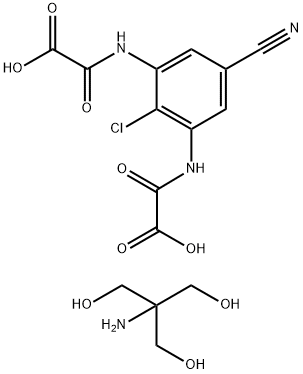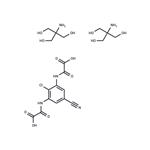
Lodoxamidetromethamine
- Product NameLodoxamidetromethamine
- CAS63610-09-3
- CBNumberCB51074423
- MFC15H17ClN4O9
- MW432.77
- MDL NumberMFCD04112765
- MOL File63610-09-3.mol
Chemical Properties
| storage temp. | under inert gas (nitrogen or Argon) at 2–8 °C |
| solubility | DMSO: 20 mg/mL (36.11 mM and warming) |
| form | Solid |
| color | White to light yellow |
| FDA UNII | 50LV9A548L |
Lodoxamidetromethamine Price
| Product number | Packaging | Price | Product description | Buy |
|---|---|---|---|---|
| ChemScene CS-6465 | 100mg | $240 | Lodoxamide(tromethamine) 99.37% |
Buy |
| ChemScene CS-6465 | 5mg | $50 | Lodoxamide(tromethamine) 99.37% |
Buy |
| ChemScene CS-6465 | 10mg | $70 | Lodoxamide(tromethamine) 99.37% |
Buy |
| AK Scientific 9710AB | 1mg | $73 | Lodoxamidetromethamine |
Buy |
| AK Scientific 9710AB | 5mg | $87 | Lodoxamidetromethamine |
Buy |
Lodoxamidetromethamine Chemical Properties,Usage,Production
Description
Lodoxamide tromethamine was launched as an ophthalmic formulation for the treatment of allergic conjunctivitis. It appears to act as a mast cell stabilizer inhibiting degranulation and the release of histamine and other vasoactive products in a similar manner to sodium cromoglycate. The compound is also under investigation as an orally active antiallergic/antiasthmatic agent.Originator
Upjohn (U.S.A.)Uses
cataract treatmentbrand name
Alomide (Alcon);Almide.General Description
Lodoxamidetromethamine, N, N -(2-chloro-5-cyano-m-phenylene)dioxamicacid (Alomide), is a white crystalline, water-solublepowder. The only significant structural similarity betweenlodoxamide and cromolyn and nedocromil is the presence oftwo acidic groups. Lodoxamide is indicated in the treatmentof the ocular disorders including vernal keratoconjunctivitis,vernal conjunctivitis, and vernal keratitis. Lodoxamide isavailable as a 0.1% solution, with each milliliter containing1.78 mg of lodoxamide tromethamine equivalent to 1 mg oflodoxamide. The solution contains the preservative benzalkoniumchloride (0.007%) as well as mannitol, hydroxypropylmethylcellulose, sodium citrate, citric acid, edetatedisodium, tyloxapol, hydrochloric acid and/or sodium hydroxide(to adjust pH), and purified water.The dose for adults and children older than 2 years of ageis 1 to 2 drops in each affected eye 4 times daily for up to 3months. The most frequently reported ocular adverse experienceswere transient burning, stinging, or discomfort oninstillation.
Preparation Products And Raw materials
Lodoxamidetromethamine Supplier
Global(98)Suppliers
| Supplier | Tel | Country | ProdList | Advantage | |
|---|---|---|---|---|---|
| +86-0371-55170693 +86-19937530512 |
info@tianfuchem.com | China | 21632 | 55 | |
| +86-0371-86658258 +8613203830695 |
sales@coreychem.com | China | 29871 | 58 | |
| 18627774460 | faith@widelychemical.com | CHINA | 742 | 58 | |
| +1-631-485-4226 | inquiry@bocsci.com | United States | 19553 | 58 | |
| +86-023-6139-8061 +86-86-13650506873 |
sales@chemdad.com | China | 39894 | 58 | |
| +86-29-87569266 15319487004 |
1015@dideu.com | China | 3939 | 58 | |
| +1-781-999-5354 +1-00000000000 |
marketing@targetmol.com | United States | 32161 | 58 | |
| +8618660799346 | sales@qinmuchem.com | China | 1009 | 58 | |
| +86-0571-85134551 | sales@afinechem.com | China | 15352 | 58 | |
| +1-708-310-1919 +1-13798911105 |
sales@invivochem.cn | United States | 6391 | 58 |
Lodoxamidetromethamine Spectrum
63610-09-3, LodoxamidetromethamineRelated Search
PROMPT×
PROMPT
The What'sApp is temporarily not supported in mainland China
The What'sApp is temporarily not supported in mainland China
Cancel
Determine


